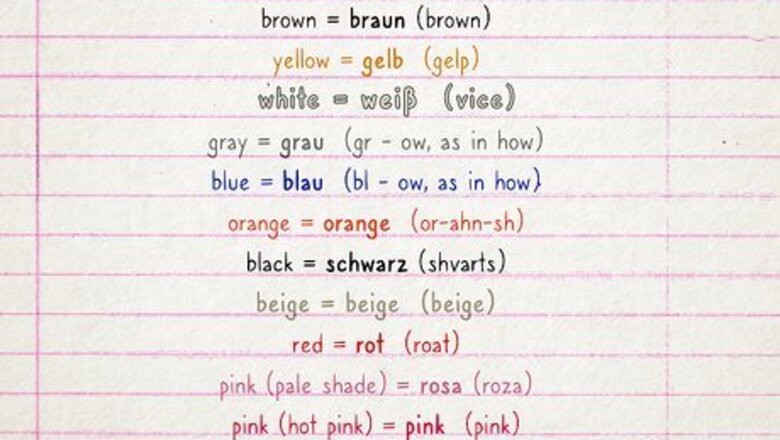
views
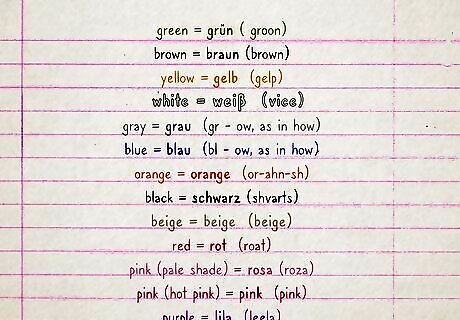
Learn some basic colors: Green = grün [ɡʁyːn] (pronunciation: groon) Brown = braun [bʁaʊ̯n] (brown) Yellow = gelb [ɡɛlp] (gelp) White = weiß [vaɪs] (vice) Gray = grau [ɡʁaʊ] (gr - ow, as in how) Blue = blau [blaʊ] (bl - ow, as in how) Orange = orange [oˈʁaŋʃ] (or-ahn-sh) Black = schwarz [ʃvaʁt͡s] (shvarts) Beige = beige [beːʃ] (beige) Red = rot [ʁoːt] (roat) Pink = rosa [ˈʁoːza](roza) this refers to a light, pale shade of pink Pink = pink [pɪŋk] (pink) this is a strong or hot pink Purple = lila [ˈliːla] (leela)
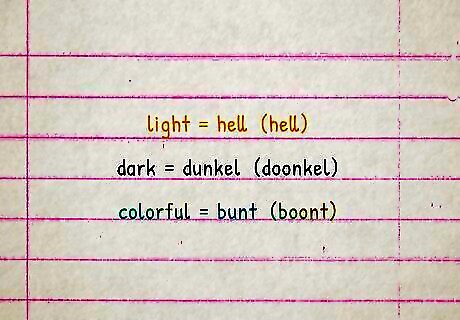
Note that there are a few adjectives you can describe colors (Farben). You can combine these adjectives with the colors into one word, to produce a form that - in English - means dark (color name). Light = hell [hɛl] (hell) Dark = dunkel [ˈdʊŋkəl] (doonkel) Colorful = bunt [bʊnt] (boont)
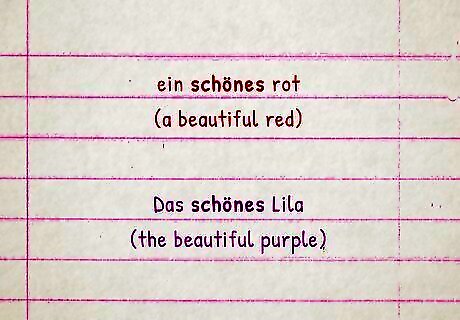
Describe a color as pretty/beautiful. use the adjective schön. The ö is pronounced like a cross between the uh in fudge and the oo in food. Examples: ein schönes rot (a beautiful red), Das schönes Lila (the beautiful purple) Why is there suddenly an -es at the end of schön? In this construction (a/the [adjective] color), the color being described is a noun. In German, adjectives describing nouns they are right next to always have endings. The -es ending is added to the adjective schön because a color is a neutral noun. All colors are neutral nouns in German, so all adjectives describing them will have the -es ending.
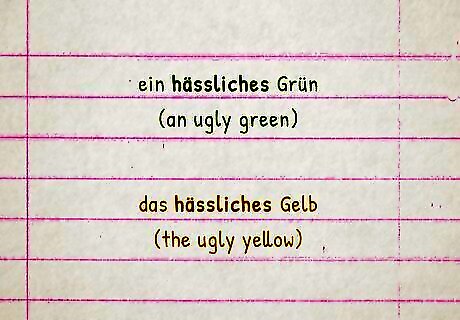
Use hässlich. The adjective hässlich may be used to describe a color as ugly. Examples: ein hässliches Grün (an ugly green), das hässliches Gelb (the ugly yellow)
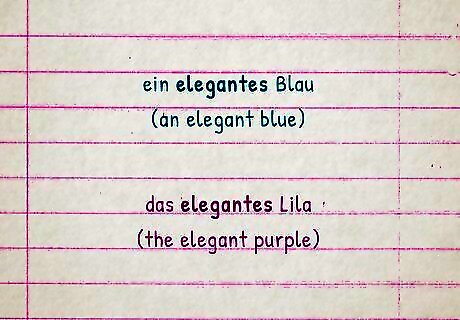
Use elegant. The adjective elegant is the same in both English and German. Examples: ein elegantes Blue (an elegant blue), das elegantes Lila (the elegant purple)
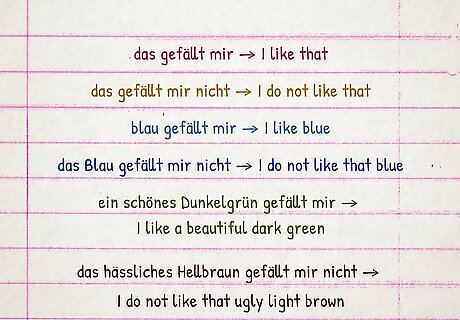
Tell someone that a certain color (or colors) please you. When German speakers talk about something they like, they use a construction which translates to “… pleases me/pleases me not”. The simplest version of this construction is “Das gefällt mir”. (That pleases me/I like that.) To negate it, we add the word nicht at the end of the sentence. “Das gefällt mir nicht” (that pleases me not/that does not please me/I do not like that.) Say it like this: Dahss gə-fellt meer nisht. You can replace “das” in the sentence with a color. “Blau gefällt mir” means “I like blue”. You can add das back in to talk about a specific color. “Das Blau gefällt mir nicht” means “I do not like the/that blue”. Add more adjectives from previous steps to be even more specific. Example: “Ein schönes Dunkelgrün gefällt mir.” (I like a beautiful dark green.) Example: “Das hässliches Hellbraun gefällt mir nicht.” (I don’t like that ugly light brown.) The colors are capitalized in the above examples because they are being used as nouns. This is not always the case, so be careful and pay attention to your writing.
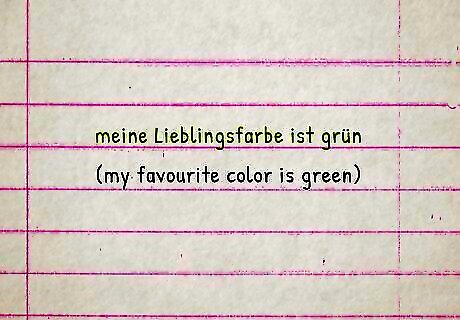
Introduce your favorite color name into a conversation. Say “Meine Lieblingsfarbe ist….” and then the German name of your favorite color. Pronounce it like this: Mine-ə Leeb-lingz-fah-bə ist…. Example: If your favorite color is green, you’d say, “Meine Lieblingsfarbe ist grün.” You could also say “… ist meine Lieblingsfarbe."
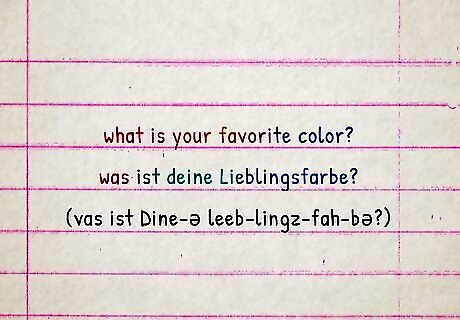
Ask for someone's favorite color. Say “Was ist deine Lieblingsfarbe?” This means “What is your favorite color?” in English. Say it like this: Vas ist Dine-ə leeb-lingz-fah-bə? The ə sound is pronounced “uh”, like the o in “position” or the e in “the”.
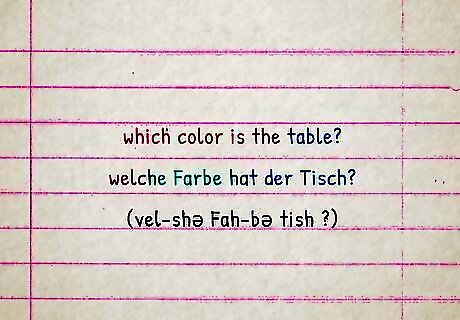
Ask for a color name. Say “Welche Farbe hat…?” Replace […] with the object about which you are inquiring and its proper article. This translates to “which color has…”. In German, we ask if things have a certain color rather than are a certain color. Say it like this: Vel-shə Fah-bə hat…. Example: “Welche Farbe hat der Tisch?” (Which color is the table?) Example: “Welche Farbe hat ihre Bluse?” (Which color is her blouse?) Remember that since color is the subject of this sentence, the object about which you are asking is the direct object. This means you will be using the German Akkusativ case, and the male article (word for the) will differ from that used in the Nominativ (subject) case. You will use “den” instead of “der” with male direct objects and the -en ending on any male pronouns.
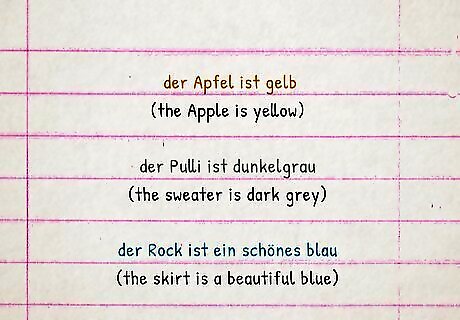
Point out which color something is in German. Say “[object] ist [color].”Although asking which color something is uses the verb hat (conjugated form of haben, meaning to have), telling the color of something uses the verb ist (conjugated form of sein, meaning to be.) Example: Der Apfel ist gelb. (The Apple is yellow.) Example: Der Pulli ist dunkelgrau. (The sweater is dark grey.) Example: Der Rock ist ein schönes blau. (The skirt is a beautiful blue.)
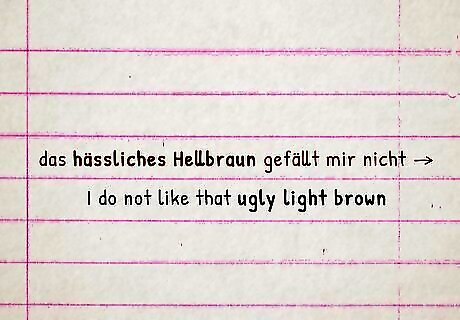
Use the German color like any adjective in English. Then, add the correct ending to the adjective. You can absolutely use multiple adjectives in addition to color to describe a noun. All adjectives describing one noun will use the same adjective ending. The endings are based on the noun’s article, gender, and plurality.


















Comments
0 comment